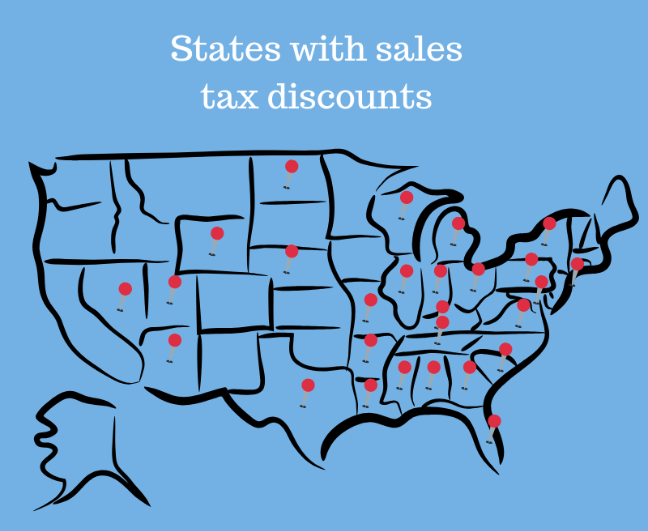
Courtesy Pixabay | Megan_Rexazin
Currently, there are 45 states plus Washington D.C. in the U.S. that require businesses to charge and collect sales tax and file/remit sales tax returns.
What should you do if you have sales tax nexus in a state? Read on for 5 steps to sales tax compliance.
STEP 1 – Know if and where you have sales tax nexus
First figure out which states you’re selling in, then determine if you have sales tax nexus in each of them.
How do you know if you have nexus in a state? Generally, if your sales in any state meet a certain threshold, it is likely that will establish nexus. You would then be required to register, collect and pay state sales tax. The amount that will establish nexus varies by state, but a fairly consistent baseline is you’ve established nexus if:
- you generated $100,000+/year in revenue
Or - you conducted more than 200 transactions in a year
What creates sales tax nexus? Do you have nexus in a state?
While the traditional qualifier or threshold was physical location in a state, the South Dakota v. Wayfair ruling in 2018 changed how nexus is defined.
In addition to the established physical presence, you have met the threshold requirement in an individual state(s) to collect, report and remit state sales tax if:
- You cross state lines to sell products at a trade show, other event or to deliver to a consumer who lives in that state.
- You have employees, sales persons or contractors working for your business in that state.
- You have any inventory in that state.
- You have any affiliate programs in that state.
If any of these statements ring true for your business, you may have nexus.
KEY POINTS TO REMEMBER:
- You only need to collect sales tax from buyers if you make a sale and ship a product to a state you have nexus in.
- If a customer buys from you and they are not in a state in which you have nexus, you do not need to collect sales tax.
- Sales tax nexus isn’t based on where YOU live or where your business is located/based out of.
- You need to register for a sales tax permit and collect sales tax in any states you have nexus in to be compliant
***Note: we are not offering legal tax advice. You should consult with a tax specialist.***
STEP 2 – Determine if you should pay tax on a product
Are your products are taxable? Many products are not taxable, and if you’re selling them, even if you have nexus in a state, you would not need to collect taxes on those items. Some of the common products that are not taxable in some states (not all – keep in mind this list varies from state to state) could include:
- Food from a grocery store
- Prescription medication
- Digital products like music and movies
- Clothing
- Medical devices
***Note: we are not offering legal tax advice. You should consult with a tax specialist.***
STEP 3 – Register for a sales tax permit
Have you registered for a sales tax permit(s)? You should register in every state you have nexus. This will allow you to legally collect sales tax. States individually handle sales tax registration, so you would search for their taxing authority online to go through the process. This is usually an organization called Dept. of Revenue or something similar. You will need a few things to register, so be prepared to submit things like:
- Your EIN
- What type of business you are
- A description of the activities your business conducts
- The shipping address FROM where you will ship your products to customers
***Note: we are not offering legal tax advice. You should consult with a tax specialist.***
STEP 4 – Set up automated sales tax collection
Set up sales tax collection for every sales channel you sell on. Be sure you know if the state you have sales tax nexus in requires either:
- Origin-based collection – you must charge the sales tax rate that is required at your business location.
- Destination-based collection – you must charge the sales tax rate that is required where the buyer’s address is. Destination-based sales tax collection is the most common (only 13 states are origin-based), and you would need to charge the applicable rates for the state, county, city and any additional local taxes that apply to the location you are shipping to.
***Note: we are not offering legal tax advice. You should consult with a tax specialist.***
STEP 5 – Report your tax & file sales tax returns
You need to diligently file your sales tax returns on time by the due date.
- Figure out how much sales tax you have collected, both in total as well as in each city, county or special taxing district. This process can be very detailed and overwhelming, virtually impossible to do manually. Or, if it happens to be one of the (not very many) origin-based states, or if they have a single state-wide sales tax rate, it could be a much simpler process. But don’t count on the latter. If you sell on multiple channels or are a high-volume seller, it would benefit you tremendously to use an automated system.
- File early to ensure you don’t run into any issues. For example, some states will require funds be paid online a few days in advance to be collected “on time.” Filing late could result in fines plus interest.
- Even if you don’t owe money (meaning you didn’t collect state sales tax), you should still file a “zero return.”
- Check to see if your state has a discount. Some states reward on-time filers with a very small (usually 1-2%) discount that you get to keep.
***Note: we are not offering legal tax advice. You should consult with a tax specialist.***

States sales tax discounts details – as of 2018
***Note: data may change frequently***
| Alabama | 5% on the first $100, 2% on the remainder; maximum of $400 per month |
| Arizona | 1%; maximum of $10,000 per year |
| Arkansas | 2%; maximum of $1,000 per month |
| Colorado | 3.33% on state sales tax; 0%–3.33% on local option tax |
| Florida | 2.5%; maximum of $30 per report |
| Georgia | 3% on the first $3,000, 0.5% on the remainder |
| Illinois | 1.75%; annual minimum of $5 |
| Indiana | 0.73% if total sales tax collected is less than $60,000; 0.53% if total is between $60,000 and $600,000; 0.26% if total is more than $600,000 |
| Kentucky | 1.75% on the first $1,000, 1.5% on the remainder; maximum of $50 per month |
| Louisiana | 0.748% (this will increase to 0.935% on July 1, 2018) |
| Maryland | 1.2% on annual collections of up to $6,000, 0.9% on the remainder; maximum of $500 per return |
| Michigan | 0.5% on the first 4% of the tax (0.75% if paid by the 12th of the month); minimum of $6 and maximum of $15,000 per month |
| Mississippi | 2%; maximum of $50 per month |
| Missouri | 2% |
| Nebraska | 2.5%; maximum of $75 per month |
| Nevada | 0.25% |
| New York | 5%; maximum of $200 per quarter |
| North Dakota | 1.5%; maximum of $110 per month |
| Ohio | 0.75% |
| Oklahoma | 1%; maximum of $2,500 per month |
| Pennsylvania | 1%; minimum of $25 per month |
| South Carolina | 3% on the first $100, 2% on the remainder; maximum of $10,000 per year |
| South Dakota | 1.5%; maximum of $70 per month; applies to electronic filers only |
| Texas | 0.5%; an additional discount of 1.25% applies to early payments |
| Utah | 1.31% |
| Virginia | 1.1% (1.6% for food) on the first $62,500; 0.84% (1.2% for food) on $62,500 to $208,000; 0.56% (0.8% for food) on the remainder; no discount on local tax; no discount for electronically filed returns |
| Wisconsin | 0.5%; minimum of $10 and a maximum of $1,000 per reporting period |
| Wyoming | 1.95% on the first $6,250, 1% on the remainder; maximum of $500 per month |
State sales tax nexus can be confusing and may feel overwhelming for eCommerce businesses. Let Freestyle take the headache out of sales tax collection. Our integration with TaxJar means you can have worry-free sales tax collection, reporting and remittance. Learn more about our M.O.M TaxJar module today. Or contact us with any tax compliance related questions.



![[EBOOK] Learn How to Simplify Online Sales Tax Compliance](https://www.freestylesolutions.com/wp-content/uploads/2024/04/online-sales-tax-500x383.jpg)

